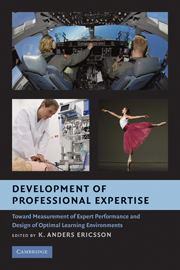 Development of Professional Expertise
Development of Professional Expertise Published online by Cambridge University Press: 04 August 2010
When one mentions the word “professional,” images come to mind of lone doctors or lawyers pursuing their practice as they see it. Romantic as this image may be, in the 21st century professionals typically practice in an organizational setting (Mumford, Scott, Gaddis, & Strange, 2002). In these settings, leadership of the organization is a critical influence on the productivity of professionals (West, Borrill, Dawson, Brodbeck, Shapiro, & Haward, 2003). This rather straightforward observation has an important, albeit often overlooked, implication. To ensure the productivity of professionals, one must also ensure that they are led effectively.
Over the course of the last century the study of leader effectiveness has come to preoccupy, if not obsess, the social sciences (Bass, in press; Yukl, 2002). Broadly speaking, this research has given rise to two major approaches that have sought to enhance performance of those who lead other professionals. More specifically, one might 1) select to employ effective leaders or 2) seek to train or develop current employees into effective leaders (Bray & Howard, 1988; Day, 2000). These two approaches implicitly assume that differences in leadership performance can be measured objectively in terms of the output of the group or system. Over the years, a host of techniques have been proposed for leader development and leader assessment – techniques ranging from assessment centers (Byham & Thornton, 1986) to classroom instruction (Fiedler, 1996) to real-world experience (McCauley, Ruderman, Ohlott, & Morrow, 1994).
To save this book to your Kindle, first ensure no-reply@cambridge.org is added to your Approved Personal Document E-mail List under your Personal Document Settings on the Manage Your Content and Devices page of your Amazon account. Then enter the ‘name’ part of your Kindle email address below. Find out more about saving to your Kindle.
Note you can select to save to either the @free.kindle.com or @kindle.com variations. ‘@free.kindle.com’ emails are free but can only be saved to your device when it is connected to wi-fi. ‘@kindle.com’ emails can be delivered even when you are not connected to wi-fi, but note that service fees apply.
Find out more about the Kindle Personal Document Service.
To save content items to your account, please confirm that you agree to abide by our usage policies. If this is the first time you use this feature, you will be asked to authorise Cambridge Core to connect with your account. Find out more about saving content to Dropbox.
To save content items to your account, please confirm that you agree to abide by our usage policies. If this is the first time you use this feature, you will be asked to authorise Cambridge Core to connect with your account. Find out more about saving content to Google Drive.